
Tarps cover the spill site of PFAS-infused firefighting foam concentrate at an entrance to the Red Hill Bulk Fuel Storage Facility in Honolulu, Dec. 9, 2022. (Matthew Mackintosh/U.S. Army)
FORT SHAFTER, Hawaii — The Navy has identified 20 sites on and near Joint Base Pearl Harbor-Hickam suspected of contamination by PFAS “forever” chemicals, but cleanup could take decades, according to a federal government watchdog.
“The Navy is taking steps to assess these sites and, where appropriate, develop plans for their long-term cleanup,” the Government Accountability Office said in a report released Monday.
Long-term cleanup for some sites could take more than 30 years, the report states.
PFAS, or perfluoroalkyl and polyfluoroalkyl, is a class of hazardous chemicals that have been commonly used in manufacturing and fire suppressants since the 1950s.
The Environmental Protection Agency refers to PFAS components as “forever” chemicals because they persist in the environment and do not break down readily.
PFAS exposure may lead to a variety of health effects, including an increased risk of cancer, according to the EPA.
Last week, the EPA finalized a rule that established the first-ever nationally enforceable drinking water standard for six PFAS substances.
Among those are perfluorooctane sulfonate, or PFOS, and perfluorooctanoic acid, or PFOA, which have been among the most widely used PFAS compounds in America.
Hawaii’s congressional delegation requested the GAO report in response to a November 2022 spill of about 1,100 gallons of a PFAS-infused firefighting foam concentrate at the Red Hill Bulk Fuel Storage Facility near the joint base.
The accidental release from a tank near the top level of the massive underground facility followed a jet fuel leak a year earlier that had contaminated the Navy’s drinking water distribution system. The Navy is in the process of decommissioning the facility.
The firefighting foam incident “raised concerns about how the Navy would remediate PFAS contamination at the installation,” the GAO report states.
In September, the Navy conducted sampling tests for PFAS at 21 wells in the vicinity of the Red Hill fuel facility.
“This sampling found low-level PFAS detections in four wells that exceeded the state of Hawaii groundwater screening levels,” the GAO report states.
“DOD officials stated they are not concerned that these PFAS detections will impact drinking water as the nearest drinking water well is upgradient and approximately six miles away.”
Navy officials told the GAO that the PFAS detected in the wells was not from the 2022 accidental spill at the fuel facility.
In a report submitted to the EPA in November, the Navy identified 124 potential “areas of interest” for PFAS contamination on and near Joint Base Pearl Harbor-Hickam, the GAO report states.
Those sites included all aircraft hangars, locations of known or suspected jet fuel fires, firefighting foam training sites and other locations possibly used for storing the foam, the GAO report states.
The Navy found that 20 of those sites, including the area of the Red Hill spill, had known of potential releases of firefighting foam.
The Defense Department has directed that the investigation and cleanup of those sites advance under the Comprehensive Environmental Response, Compensation, and Liability Act of 1980, more commonly referred to as the EPA’s “Superfund,” the GAO report states.